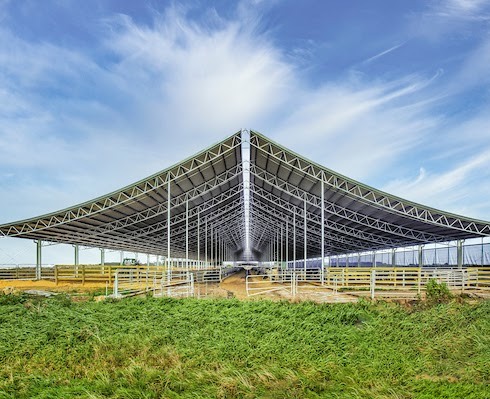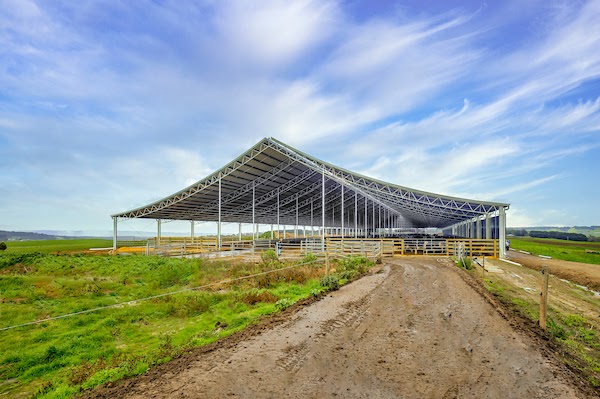How Technology is Transforming Dairy Farms
- On : January 1, 2021
- By : Entegra Signature Structures
The dairy industry has faced several challenges over recent decades. Arguably, the biggest of these challenges is a reduction in the number of dairy farms. For example, in Australia, the number of dairy farms has decreased by 75% over the last 40 years.
This means that the remaining farmers have to increase efficiency and yield in order to meet demand and remain competitive. Improvements in technology have been at the centre of making this happen and this continues to be the case.
Key points
- Number of dairy farms has decreased by 75%
- The Woolworths Dairy Innovation Fund was set up to deliver $5 million in grants with up to $100,000 each being allocated to each grant.
- Sensors, drones & bovine wearables are commonly used
- The Ridgeback ™ barn increases air exchange per hour, reduces heat stress & increases milk production
Need a Quote?
Entegra Dairy Shed
Housing dairy cows
RECOMMENDED ARTICLE
Managing cow heat stress to cut production losses – Entegra Signature Structures
The growth of technology
In order to address recent challenges, the dairy industry has embraced the use of technology in dairy farms. This has changed the face of the industry and will continue to do so. Several modern products and facilities exist today that farmers could only have dreamed of in the past.
This includes the use of sensors to collect information about cattle and their surroundings. It also includes the use of gate sensors to enable access to pastures and enclosures for herds.
Companies like Woolworths provide financial encouragement to dairy farmers to encourage them to improve in areas such as sustainability and efficiency. The Woolworths Dairy Innovation Fund was set up to deliver $5 million in grants with up to $100,000 each being allocated to each grant.
Innovative projects can be considered for the fund. These projects build on the innovative use of technology that already exists in the industry. Let’s examine some examples of this technology.
Sensors
Sensors can be used on cattle, to capture their physical attributes and behavioural patterns. They can also be used on farm equipment and in fields to detect weather patterns and nutrient levels. Sensors can also help farmers to keep track of their herds and learn more about grazing patterns. This is all valuable information for dairy farms that need to ensure optimal use of resources.
RECOMMENDED ARTICLE
Housing dairy cows for a more profitable industry – Entegra Signature Structures
Bovine wearables
Human wearables, like the Fitbit, have become fashionable in recent years. They enable the wearer to better understand their fitness and diet routines. Wearables are now also available for cows.
The animals can wear collars which provide information about factors such as rumination and movement. This helps professionals in the dairy industry to keep a check on a cow’s health and the happiness of cows in order to optimise milk yield and milk quality.
Wearables can also provide information about when a cow is in heat. This allows farmers to arrange for insemination to happen at the best time to make sure the pregnancy is successful and healthy.
Drones
Drones have become a more frequent sight in the sky in recent years. They have various uses including mapping, photography, and simply as a hobby. There are several ways that drones can be useful to dairy farmers.
They can be used to check if everything is alright with a herd, to save a farmer from visiting the pasture. They can also be useful when farmers are trying to locate a stray animal.
Robotic milking systems
Traditionally having to milk the cows has been a time-consuming activity in the dairy industry. However, innovative solutions like the one instigated by Future Dairy in Australia, allow farmers to use Automatic Milking Systems (AMS).
This area of innovation continues to be developed in a joint initiative between the NSW Department of Primary Industries, Dairy Australia, and DeLaval known as Milking Edge. The continuing work is based on the original development by Future Dairy and years of intensive research.
The use of data
Big data is big news in a range of industries today and dairy farming is no exception. Some of the technology already mentioned in this article forms part of the collection of data. This includes the use of sensors and bovine wearables.
The information that these devices gather can be used by dairy farmers, and other businesses along the supply chain in the dairy industry, to optimise the way they work.
They can make use of the information to understand how much milk to produce, how to optimise the efficiency of milk production, and where to base their herds. All of these decisions are backed by reliable and current data.
These examples of technology are all integral to helping dairy farmers deliver and survive in a competitive industry. They do this by enabling dairy farms to operate dairy production activities in a sustainable and efficient manner.
Ridgeback™ Technology
The globally patented climate controlled design of the Ridgeback™ is the best dairy shed available. The turn-key design has 20% higher air exchanges per hour compared to traditional dairy sheds and a leading farm in south west Victoria is reporting significant production gains..
A dairy farm in south west Victoria has achieved production improvements with a Ridgeback™
The business is on track to reach production of 12,000 – 14,000 litres per lactation and milking three times per day. This is a significant increase of more than 50 per cent from the current average per production and 127 per cent more than the average Australian cows’ milk production.
The land surrounding the dairy and barn, previously grazed by the herd, is now used to grow ryegrass pastures and crops which are fed back to the milking cows. Gains in milk production will provide the return on the investment for the barn.
Improvements in cow wellbeing – and a resulting decline in animal health expenses – as well as better yielding pastures and crops, due to less compaction and destruction from cows, are just added bonus.
For the complete case study email [email protected] or click here (add link for contact form)
RECOMMENDED ARTICLES
Managing cow heat stress to cut production losses – Entegra Signature Structures
Milking cows in the heat – Entegra Signature Structures
The Story of Australia’s First Dairy Cows – Entegra Signature Structures
Heat Stress in Dairy Cows – Entegra Signature Structures
https://www.megalac.com/about/news/151-how-new-technology-is-transforming-dairy-farming
https://www.dairyaustralia.com.au/en/industry-statistics/cow-and-farms-data#.X_jBvNj7RPY


